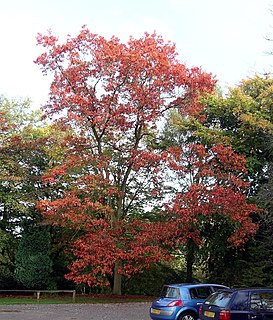
Quercus rubra, the northern red oak, is an oak tree in the red oak group. It is a native of North America, in the eastern and central United States and southeast and south-central Canada. It has been introduced to small areas in Western Europe, where it can frequently be seen cultivated in gardens and parks. It prefers good soil that is slightly acidic. Often simply called red oak, northern red oak is so named to distinguish it from southern red oak (Q. falcata), also known as the Spanish oak. Northern Red Oak is sometimes called champion oak.

Quercus muehlenbergii, the chinquapin or chinkapin oak, is a deciduous species of tree in the white oak group. The species was often called Quercus acuminata in older literature. Quercus muehlenbergii is native to eastern and central North America. It ranges from Vermont to Minnesota, south to the Florida panhandle, and west to New Mexico in the United States. In Canada it is only found in southern Ontario, and in Mexico it ranges from Coahuila south to Hidalgo.

Quercus velutina, the black oak, is a species of oak in the red oak group, native and widespread in eastern and central North America. It is sometimes called the eastern black oak.

Quercus coccinea, the scarlet oak, is a deciduous tree in the red oak section Lobatae of the genus Quercus, in the family Fagaceae.
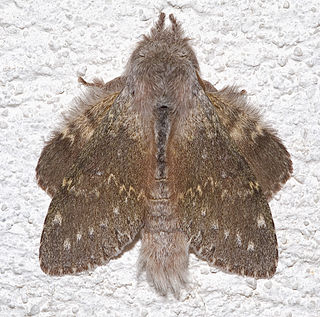
The lobster moth, also known as lobster prominent, is a moth from the family Notodontidae. The species was first described by Carl Linnaeus in his 10th edition of Systema Naturae. The English name refers to the crustacean-like appearance of the caterpillar.
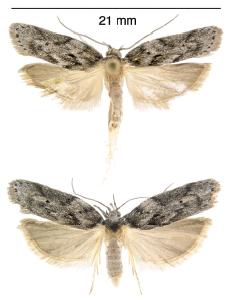
Antaeotricha arizonensis is a moth of the family Depressariidae. It is found in the United States in the mountain ranges in south-eastern Arizona and south-western New Mexico. Although Antaeotricha arizonensis are easily differentiated within their genus through the dark spots on their forewings, the distinction between sexes of A. arizonensis can be complicated. The sexes of A. arizonensis (male&female) differentiate between themselves by distinct characteristics on their antennas and anatomy of their genitalia(Ferris, 59)
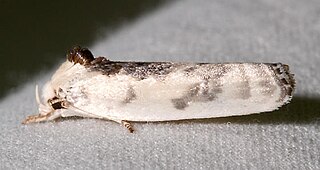
Antaeotricha is a genus of moths. It is the largest genus in the subfamily Stenomatinae, numbering over 400 species in the Western Hemisphere.
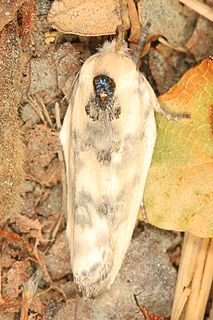
Antaeotricha schlaegeri, the Schlaeger's fruitworm moth, is a species of moth of the family Oecophoridae. It is found in north-eastern North America, south to North Carolina and west to Kansas and Texas.
Dyseriocrania auricyanea is a moth of the family Eriocraniidae. It was first described by Baron Walsingham in 1882 and is found in California.
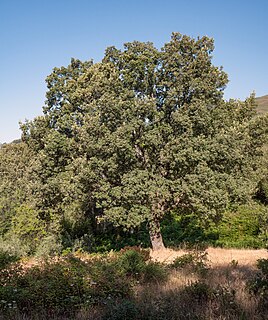
Quercus pyrenaica, commonly known as Pyrenean oak, is a tree native to southwestern Europe and northwestern North Africa. Despite its common name, it is rarely found in the Pyrenees Mountains and is more abundant in northern Portugal and north and northwestern Spain.
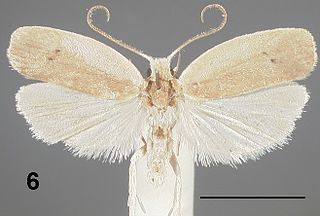
Antaeotricha osseella is a moth of the family Depressariidae. It is found in North America, where it has been recorded from New York, New Jersey, North Carolina, South Carolina, West Virginia, Maryland, District of Columbia, Massachusetts, Pennsylvania, Illinois, Arkansas, Missouri, Texas and California.

Antaeotricha albulella, the vestal moth, is a moth in the family Depressariidae. It was described by Francis Walker in 1864. It is found in the United States where it has been recorded from Alabama, Florida, Georgia, Louisiana, Maryland, Mississippi, New Jersey, North Carolina, Oklahoma, South Carolina, Texas and West Virginia.

Antaeotricha floridella is a moth of the family Depressariidae. It is found in North America, where it has been recorded from peninsular Florida.
Antaeotricha walchiana is a moth of the family Depressariidae. It is found in Venezuela, Panama, Trinidad, Colombia, French Guiana, Brazil, Bolivia and Peru.
Antaeotricha humerella is a moth of the family Depressariidae. It is found in Brazil (Amazonas), French Guiana, Guyana and Panama.
Antaeotricha thysanodes is a moth of the family Depressariidae. It is found in Guyana, French Guiana and Brazil.
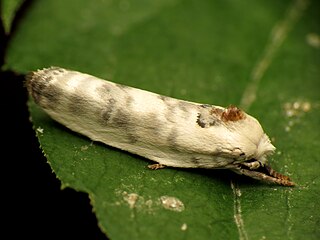
Antaeotricha leucillana, the pale gray bird-dropping moth, is a moth in the family Depressariidae. It was described by Philipp Christoph Zeller in 1854. It is found in North America, where it has been recorded from New Hampshire, Massachusetts, New York, Pennsylvania, District of Columbia, Virginia, North Carolina, Georgia, Alabama, Arkansas, Missouri, Kansas, Illinois, Iowa, Texas, Oregon, Louisiana, Manitoba and Nova Scotia.
Antaeotricha humilis, the dotted anteotricha moth, is a moth in the family Depressariidae. It was described by Philipp Christoph Zeller in 1855. It is found in North America, where it has been recorded from Alabama, Arkansas, Florida, Georgia, Illinois, Indiana, Kansas, Kentucky, Louisiana, Maryland, Mississippi, New Jersey, North Carolina, Ohio, Oklahoma, South Carolina, Tennessee, Texas, Virginia and West Virginia.
Antaeotricha lindseyi is a moth in the family Depressariidae. It was described by William Barnes and August Busck in 1920. It is found in North America, where it has been recorded from California, Arizona and New Mexico.
Antaeotricha unipunctella is a moth in the family Depressariidae. It was described by James Brackenridge Clemens in 1863. It is found in North America, where it has been recorded from Alabama, Arizona, Florida, Illinois, Indiana, Louisiana, Maine, Massachusetts, Mississippi, South Carolina, Tennessee and Texas.











